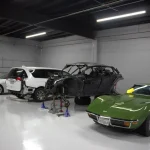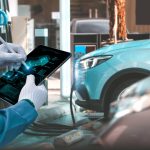Remember when a car’s biggest security threat was a simple lockpick? Yeah, those days are long gone. Today’s vehicles are essentially smartphones on wheels—powerful computers connected to the internet, talking to other cars, and managing everything from your entertainment to your steering.
And with that incredible connectivity comes a new kind of risk. Automotive cybersecurity isn’t some futuristic concept; it’s the essential shield protecting your vehicle from digital highwaymen. Let’s pop the hood on this critical topic.
Why Your Car is a Rolling Computer (and a Target)
A modern luxury vehicle can contain over 100 million lines of code and up to 150 separate electronic control units (ECUs). These are the tiny computers that control the engine, brakes, infotainment system, you name it. They’re all talking to each other over the car’s internal network.
Now, connect that intricate network to the outside world via 5G, Wi-Fi, and Bluetooth. You’ve just created what security experts call an “attack surface.” Hackers don’t need to physically touch your car anymore. They can potentially find vulnerabilities in the software that runs it.
The stakes? They’re incredibly high. We’re not just talking about someone stealing your playlist. A successful breach could lead to:
- Privacy Invasion: Access to your location history, microphone, and personal data.
- Theft: Keyless entry and ignition systems can be mimicked.
- Safety Risks:In a worst-case scenario, critical systems like brakes or steering could be compromised.
The Digital Weak Spots: How Hackers Get In
So, how do these digital intrusions actually happen? The entry points are more varied than you might think. It’s not just one door; it’s several windows left slightly ajar.
Infotainment Systems & Mobile Apps
That slick touchscreen is a prime target. A malicious file on a USB stick, a compromised smartphone connection, or a vulnerability in the car’s companion app can serve as a gateway to the deeper vehicle network. It’s like a Trojan horse, but for your dashboard.
V2X Communication (Vehicle-to-Everything)
This is the tech that lets cars chat with traffic lights, other vehicles, and road infrastructure. It’s brilliant for safety and traffic flow. But an unsecured V2X signal can be spoofed. Imagine a hacker broadcasting a “phantom” car that causes your vehicle to slam on the brakes unnecessarily.
Aftermarket Devices & Chargers
That cheap, off-brand dongle you plugged into the OBD-II port to monitor your fuel efficiency? Or a compromised public EV charger? These can be unexpected backdoors, providing direct access to the car’s central nervous system.
Supply Chain Vulnerabilities
Here’s the thing—car manufacturers don’t build every single software component in-house. They rely on a vast network of suppliers. A weakness in a third-party part, maybe a single chip, can create a vulnerability in thousands of vehicles before anyone even realizes it.
The Industry’s Evolving Defense Strategy
Okay, enough with the scary stuff. What’s being done? Honestly, the auto industry has had to do a crash course in cybersecurity, and the defenses are getting smarter every day. It’s a multi-layered approach, often called “defense in depth.”
| Security Measure | How It Protects Your Car |
| Secure Boot & Hardware Security Modules | Ensures only trusted, cryptographically signed software can run on the vehicle’s ECUs. It’s like a bouncer checking IDs at the door of every computer in your car. |
| Intrusion Detection & Prevention Systems (IDS/IPS) | Continuously monitors the car’s internal network for suspicious activity. If it sees something weird, it can alert the driver and/or the manufacturer, and even block the malicious commands. |
| Over-the-Air (OTA) Updates | This is a game-changer. Instead of waiting for a recall, manufacturers can push software patches directly to your car to fix vulnerabilities, just like your phone updates. It’s absolutely critical for long-term connected car protection. |
| Network Segmentation | This involves creating digital firewalls between different systems. So, even if a hacker gets into the infotainment system, they’re blocked from accessing critical driving functions like the brakes or steering. |
What You Can Do: Your Role in Car Cybersecurity
You’re not just a passenger in this. Car owners have a real part to play. Think of it as digital hygiene for your vehicle. Here are a few simple but powerful habits to adopt.
- Install Updates Promptly: When you get a notification for a software update from your carmaker, don’t ignore it. Treat it with the same urgency as a critical phone update. It’s often your first line of defense.
- Be Smart with Connectivity: Disable Wi-Fi and Bluetooth when you’re not actively using them. It reduces your car’s attack surface. And think twice before connecting to public Wi-Fi networks with your vehicle.
- Choose Accessories Wisely: Be cautious with third-party dongles and aftermarket devices. Stick to reputable brands and understand what data they access.
- Practice Basic Digital Security: Use strong, unique passwords for your connected car apps and associated accounts. This seems obvious, but it’s a common weak link.
The Road Ahead: A Shared Responsibility
The landscape of automotive cybersecurity is a constant arms race. As cars become even more autonomous and connected, the potential attack vectors will evolve. The industry’s shift from a one-time security check at the factory to a “security-by-design” mentality, with continuous monitoring and updates, is the only sustainable path forward.
For us as drivers, it means rethinking our relationship with our cars. They are no longer just mechanical beasts; they are complex, living digital ecosystems. Protecting them requires vigilance from everyone—the manufacturers, the regulators, and yes, the person in the driver’s seat.
The goal isn’t to create fear. It’s to foster awareness. The benefits of connected cars—from incredible safety features to seamless convenience—are far too great to abandon. But embracing this future means taking its security just as seriously as we take the airbags and seatbelts. After all, in today’s world, digital safety is just another fundamental part of the journey.










